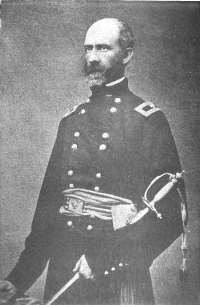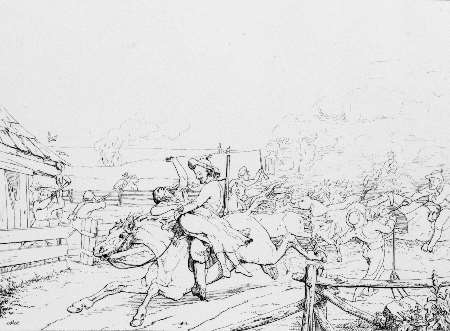Search:
Powered by
Website Baker
The Missouri-Kansas Border War
Next Scheduled Class – n/a
From 1854 through 1859, the Missouri-Kansas border was the scene of intense rivalry between pro-slavery and free-state factions. Both sides used intimidation and violence to such an extent that the time period came to be known as “Bleeding Kansas.” By 1859, Free-State supporters had won control of the Territorial Legislature and drafted a State Constitution, which was approved two to one in a referendum on October 4, 1859. In January 1861, Kansas finally received Congressional approval and was admitted to the Union as the 34th State.
Now it's 1861 and the Missouri-Kansas border has settled into an uneasy truce. Pro-slavery Missourians have resigned themselves to co-existing with a neighbor on their western border in which slavery is illegal. But Missourians now turned their attention to events taking place in the Deep South. After seceding from the United States of America, seven states combined in February 1861 to form the Confederate States of America. Although a minority of pro-slavery men in Missouri were in favor of secession and joining the Confederacy, a large majority of Missourians favored the status quo. In March 1861, the Missouri State Convention passed a resolution which said Missouri would remain part of the United States of America.
President-elect Abraham Lincoln knew it was important to keep the Border States where slavery was legal in the Union. In 1861, Lincoln wanted the coming war to be about saving the Union and not about abolishing slavery. Missouri was important to Lincoln’s war strategy. It won’t take much for the region to blow up. Missouri was going to become a constant distraction to President Abraham Lincoln.
At the start of 1861, Missouri appeared to be one of the few slave states in the nation where its citizens overwhelmingly felt that preserving the Union was important. Secession was only an option of last resort. But by the summer of 1862, all calls for reason had disappeared and Missouri was being wracked by guerrilla warfare.
 After returning from a scout in the Summer of 1862, Colonel Fitz Henry Warren, commanding the First Iowa Volunteer Cavalry Regiment, had the following to say about the nature of the guerrilla warfare in Missouri:
After returning from a scout in the Summer of 1862, Colonel Fitz Henry Warren, commanding the First Iowa Volunteer Cavalry Regiment, had the following to say about the nature of the guerrilla warfare in Missouri:
Murder, plunder, and outrage are rife … It is to be a war of extermination. There is no half-way house and no neutral position. We are to be driven out and annihilated or they are. It is an inveterate, malignant hatred, which will last to the end of life …
How did the border devolve into a “war of extermination?”
This class tells the story of the Missouri-Kansas Border War during the American Civil War. Dick tells this story using the diaries, letters, speeches, and memoirs of the people who were there. Photographs of the participants and sketches and photos of battle sites will be shown during the class.
Instructor: Dick Titterington is an amateur historian who has focused much of his energies on the events that took place in Missouri and Kansas before, during and after the American Civil War.
Course Objectives
• Learn how the Missouri-Kansas border went from a position of neutrality to a war of brutality and atrocity.
• Learn about the events along the Missouri-Kansas border during the first three years of the American Civil War.
• Learn why Missourians chose to fight a guerrilla war.
• Learn who the regional decision makers were and what decisions changed the course of events in the region.
• We will find out what events convinced Federal authorities to issue the infamous Order Number 11 and whether or not it succeeded in accomplishing its objectives.
• Learn why some consider it odd that a jayhawk is used as the mascot for a major university's sports teams.
The Protagonists
• We will meet some jayhawkers like Charles R. Jennison and James H. Lane.
• We will meet some Missouri Guerrillas like Cole Younger and William Quantrill.
• We will meet some Federal Officers like Thomas Ewing, Jr. and John M. Schofield.
• We will meet some Confederate Officers like Upton Hays and Sterling Price
• We will meet some Civilians like George Caleb Bingham and Margaret Watts Hays
Partial List of Topics
• Jennison’s Jayhawkers
• Lane’s Kansas Brigade
• The Battle of Dry Wood Creek
• The Sack of Osceola
• Quantrill Becomes A Guerrilla
• The First Battle of Independence
• The Battle of Lone Jack
• Quantrill Raids Kansas Towns
• Collapse of Union Prison in Kansas City
• The Lawrence Massacre
• Order Number 11
• The Burnt District
